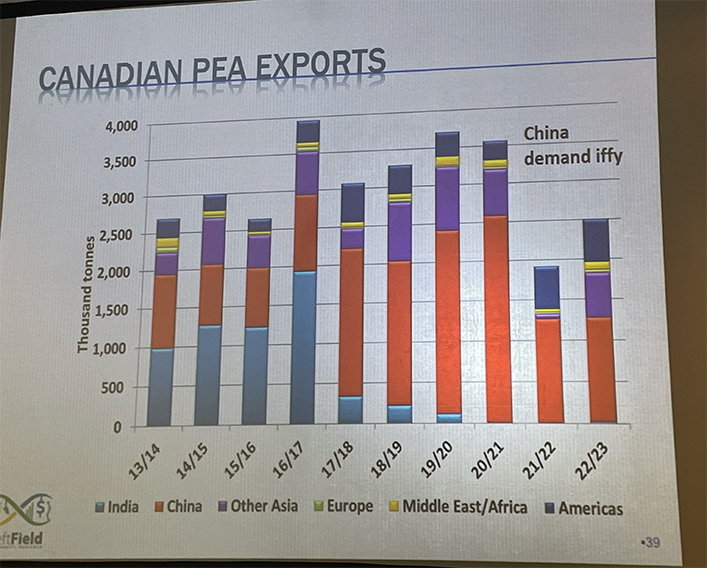Chinese feed pea demand has evaporated, says an analyst.
The country imported 2.5 million tonnes of Canadian peas in 2020-21. This year it will likely be about half of that amount, according to Chuck Penner, analyst with LeftField Commodity Research.
China was buying boatloads of the product every month in 2020-21 because yellow pea prices were well below soybean meal prices at that time.
Read Also

U.S. bill could keep out Canadian truckers
The Protecting America’s Roads Act, which was tabled in the U.S. House of Representatives at the beginning of October, would “rid the country of illegal immigrant commercial truck drivers and ineligible foreign nationals.”
That hasn’t been the case this year, with yellow pea bids in the $11 to $12 per bushel range.
However, the spread between soymeal and yellow pea prices may be widening.
“Just in the last few weeks we’re seeing soymeal prices start to rise again in China,” Penner told delegates attending a market outlook session at the annual general meetings of Saskatchewan’s crop organizations.
He is forecasting 350,000 tonnes of Canadian yellow pea ending stocks, which is “fairly comfortable,” but that could tighten quite a bit if China starts importing feed peas in the coming months.
Green pea ending stocks are forecast at 50,000 tonnes, which is tight.
Both types of peas usually achieve their seasonal price highs in the spring, so he doesn’t expect much price weakness in yellow peas until the months following seeding.
Russia’s new phytosanitary agreement with China is also something to watch because Russia could start to “eat away at the edges” of a market that has belonged to Canada.
Russian farmers harvested a whopping 3.6 million tonnes of peas in 2022, so they have plenty of supply. Most of that production is consumed domestically but it does ship some peas to Turkey and other countries.
Penner is forecasting a 10 percent drop in Canadian pea acres in 2023 to three million acres.
Australia is going to provide stiff competition for Canada in lentil markets this year. Farmers in that country harvested an estimated 1.05 million tonnes of the pulse crop.
That product will start hitting the market in January. In most years Australia is only a competitive threat to Canada for the first four or five months, but it will be in the market every month this year, said Penner.
India’s lentil imports have been sluggish through the first eight months of its 2022-23 crop year, despite the removal of import duties.
Yet somehow Canada has been exporting huge volumes of lentils, with 270,000 tonnes shipped in November, nearly double the five-year average.
“We’re really seeing some conflicting signals,” said Penner. “We’re going to be getting pretty tight on lentil supplies as we get into the second half of this year.”
That anticipated tightness is not yet showing up in red lentil bids, which have been “dead flat,” possibly because farmers under-reported their yields to Statistics Canada.
However, by the end of the year Penner is forecasting 200,000 tonnes of carryout, which is the same as the drought-reduced total last year.
“That’s a pretty friendly signal.”
Red lentil prices in origin markets like Canada and Australia are much lower than in destination markets like Turkey, India and Pakistan.
“The market is having a hard time realizing that we’re going to be tightening up supplies toward the end of the year,” Penner said.

He believes Canadian lentil plantings will remain flat at around 4.1 million acres in 2023. However, there will likely be more greens and fewer reds.
Canadian chickpea yields were disappointing. Growers harvested an estimated 125,000 tonnes of the crop, which isn’t enough to meet demand.
Exports have been above average for each of the first four months of the 2022-23 campaign, which means they will have to slow down for the remainder of the year.
Ending stocks are forecast at about 40,000 tonnes, the lowest level since 2017-18.
Penner anticipates a 35 to 40 percent increase in plantings to about 325,000 acres in 2023, but supplies will fall next year due to the paltry carry-in.
Mexico’s kabuli chickpea planting is off to a slow start this year.
Contact sean.pratt@producer.com


















